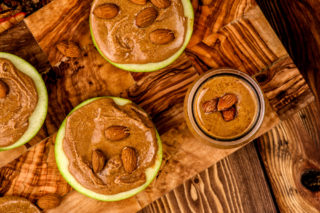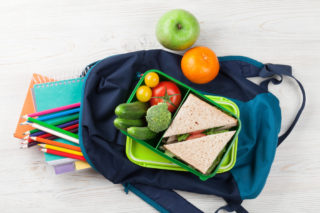By: Rebecca Mason, RDN
Parents, I totally get it: Life gets busy and packing your kids a healthy lunch every single day is another “to-do” on what may be an already overflowing plate. Especially with the added stress of COVID-19 changing up what school looks like this year. Unfortunately, it’s all too easy to be misled by catchy marketing and product labels touting healthy choices—and we don’t always have time to investigate each and every nutrition claim we read. Don’t fret, this is a judgement-free zone and I’m here to help. Here are five common lunch foods that may not have the health benefits the packaging promises.
1. (Some) nut butters
A common staple in many kid’s lunchboxes is a peanut butter sandwich. It may be tempting to trade in traditional peanut butter for a reduced fat version in an attempt to provide a “healthier” lunch, but always take a moment to scan the nutrition facts. You’ll often find that the calorie count is exactly the same, but the reduced fat version is simply higher in added sugar.
Unfortunately, the most deceiving is chocolate hazelnut spread. Thanks to clever marketing, consumers are told that the product is made with wholesome ingredients like hazelnuts, skim milk and a hint of cocoa which is, in part, true. However on closer inspection, the first two ingredients are sugar and palm oil. Keep in mind that product labels list ingredients in order of predominance with the ingredients used in the greatest amount first. So it’s no surprise that with sugar and oil being the first two ingredients that there’s a whopping 21 grams of sugar, 4 grams saturated fat and a mere 2 grams protein in a 2 tablespoon serving. Tasty, yes—but probably more appropriate for a treat than a main entrée. Take a few moments and scan your labels to choose spreads with the fewest ingredients possible. I like to use this one ingredient raw creamy almond butter in wraps, sandwiches and baked goods.

2. Veggie straws
It sure sounds like an amazing idea—you can give your kids a snack they like and it’s healthy because they’re veggies, right? Prepare for the unfortunate truth: veggie straws have a whole lot of good marketing to thank for their reputation as a health food. In fact, most veggie straws are little more than potato starch, flour, corn starch, oil and salt with some vegetable powders for coloring. True, they contain about 3 fewer grams of fat when compared to potato chips, but they certainly aren’t adding a serving of veggies to your kid’s lunchbox. Instead of straws, start infusing good habits now and encourage your little ones to munch on a variety of fresh veggies with their meals instead.
3. Granola and granola bars
The primary ingredients in many store-bought granolas are oats, sugar and fat. Add some mini marshmallows and chocolate chips and voila, your oat-based snack is really no healthier than a cookie. Make the other kids in class jealous and make a batch of these homemade apricot pine nut bars instead for a healthier lunchtime snack.
4. Yogurt
We all know that yogurt is a good source of calcium, which is great for developing bones and teeth, but unfortunately many options out there are chock-full of sugar (to the tune of 30 grams of sugar in just a 6 ounce container—ouch). To make sure the yogurt you’re packing is as healthy as it should be, choose brands high in protein and low in sugar. One of my favorite brands is siggi’s yogurt in these easy-to-pack tubes. Toss them in the freezer and your kids will be enjoying a balanced treat with lunch. As a bonus, the frozen tubes also help keep their entire lunchbox cool until the cafeteria bell rings.

5. Fruit snacks
What kid doesn’t go nuts for a package of fruit snacks? They love them because they’re sweet, fruity and chewy. But what they don’t know that they’re also loaded with corn syrup, corn starch, coconut oil and dyes—and often flavored with fruit juice or fruit puree. Save the fruit snacks for an occasional treat and pack fresh berries, a mandarin orange or sliced kiwi instead.
As you’re prepping for back-to-school and stocking up on lunch options, beware of clever marketing and remember that just like for adults—the words “healthy” and “nutritious” on food labels can often be deceiving.
Looking for more healthy lunch options for your kids? Here are seven more great tips, including recipes and recommended portion sizes, so your student’s lunchbox is as nutritious as can be—all school year long.
About the Author: Rebecca Mason, RDN, is a registered dietitian/nutritionist. She is passionate about helping families and individuals improve their health through nutrition education and nutritious food access. Rebecca is certified in adult weight management, and has a background in both clinical nutrition and wellness programming.


